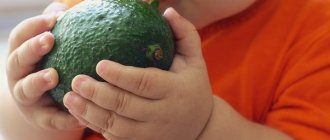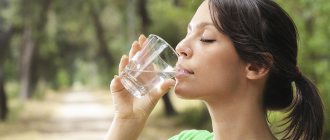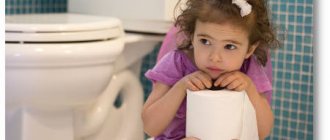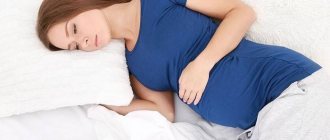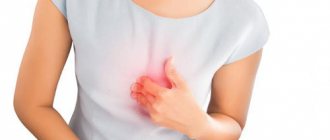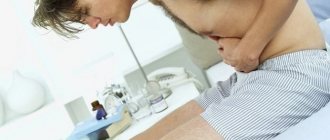Purpose, purpose of gentle nutrition for rotavirus infection
Eating properly during rotavirus infection is a beneficial condition for recovery.
Along with food, the body receives the necessary biologically active substances that help the body restore strength and normalize immune defense. In the acute period of the disease, the body is weakened - there is not enough strength and energy for a full digestive process. Therefore, during the course of the disease, food must enter the body in an easily digestible form. A diet for rotavirus infection can be a medicine to eliminate symptoms. The astringent properties of the products will help fight diarrhea. Fruit compote and decoctions of medicinal plants will help restore normal water-salt balance.
Medical nutrition
The first days of the disease are accompanied by intense vomiting and diarrhea. Symptoms lead to severe dehydration, loss of minerals and trace elements by the body. Each entry of food or water into the stomach can provoke attacks of vomiting.
- To avoid the development of vomiting and worsening the condition, reduce your daily diet, eat small meals, but more often. The number of meals during the day is at least 6-8.
- Choose cereal porridges boiled in water. Rice and semolina porridge are useful. They are characterized by an astringent effect and envelop the mucous membrane of the stomach and intestines. Another useful property of the products is the absence of fermentation processes in the intestines after consumption. Cook the porridge until semi-liquid, do not add salt, milk or butter.
- It is not recommended to consume vegetable oil or butter during the acute period. The first enhances intestinal motility and aggravates diarrhea. Due to enzymatic deficiency, which occurs due to damage to the intestinal epithelium, butter is poorly digested and absorbed by the body.
- On the third or fourth day, the diet for intestinal infections is expanded with other water-based porridges - oatmeal or corn. You can boil buckwheat.
- If the patient's condition improves, meat can be added to the diet. Proper nutrition for rotavirus infection should include lean boiled and steamed meats. Give the sick rabbit fillet, veal. It is healthy to eat chicken breast and turkey. It is better to cook steamed cutlets or meatballs from meat - this will improve digestion and absorption of healthy food components.
- The diet after rotavirus infection allows the consumption of low-fat fish.
- After the introduction of meat, the patient is allowed to eat eggs. It's better to cook a steam omelette. Remember the norm - 1-2 eggs per week.
- You can eat fruits and vegetables boiled or baked. Prepare vegetable puree in water without adding oil or salt. The patient is served potatoes, carrots, broccoli, and zucchini.
Drinks for rotavirus infection
On the first day after the onset of the disease, it is allowed to drink clean filtered water and electrolyte solutions - Regidron, Gastrolit. After the patient’s condition improves, begin to give him decoctions of rose hips and raspberries. You can drink jelly from sweet berries, compote from dried fruits. Weak black tea is allowed.
After 4-5 days of illness, you can gradually introduce kefir into the menu. Other fermented milk products are also useful - yogurt or acidophilus. These products normalize and restore microflora.
Follow the diet during the period of illness, for 2 weeks after the start of recovery. During this time, complete regeneration of the intestinal epithelium will occur, and the usual regime and diet will gradually return.
Prohibited Products
A diet for intestinal infections in children involves complete exclusion from the diet:
- Dishes made from fatty meats - chicken legs, wings, pork, lamb, duck, goose.
- Fatty fish.
- Milk, sour cream.
- Fresh vegetables, fruits. Apples are allowed baked on the 7-10th day of illness.
- Smoked, pickled products, pickles.
- Confectionery – chocolate, cakes, pastries.
- Brown bread, fresh white bread, pasta.
- Highly carbonated sweet drinks - Pepsi-Cola, Coca-Cola.
- Adult patients need to remember: alcohol is strictly contraindicated for rotavirus infection.
- It is not recommended to eat foods containing phosphoric acid as a stabilizer.
Eating foods from the list stimulates intestinal motility - leading to increased diarrhea. They cause increased fermentation and putrefaction processes in the intestines. Animal fats will not be able to be fully digested in the intestines due to the enzymatic deficiency that occurs during rotavirus infection.
Foods prohibited during illness
During the diet, it is worth excluding a number of foods that create a favorable environment for the development of bacteria. Also, you should not eat anything that can cause flatulence. Foods rich in fiber are also not suitable for dieting, as they will put a strong strain on an exhausted body.
During the diet, give up:
- milk;
- cucumbers and legumes;
- garlic and onions;
- radish, radish, cauliflower and white cabbage;
- fatty broths and soups;
- sugar-containing products (natural cocoa, chocolates, candies);
- fresh black bread and baked goods;
- high-carbohydrate cereals (millet, pearl barley) and pasta;
- canned food, semi-finished products and fast food;
- any smoked, salty and fatty foods;
- drinks containing caffeine.
Causes and symptoms of rotavirus infection
Rotavirus is called intestinal flu. This is due to the fact that pathogenic microflora develops in the small intestine. Moreover, the multiplication of enterocytes occurs rapidly. They destroy healthy cells and migrate to attack new areas. The body tries to resist infection by increasing the frequency of bowel movements. But some viruses still remain in the intestines. In a short time their population is restored.
Viruses released from the intestines are dangerous because they are a source of infection.
Rotavirus most often affects children, but adults are also at risk of contracting intestinal flu. They suffer from infection less frequently and more easily. The signs of the disease are largely identical to the symptoms of ARVI. This creates obstacles for early diagnosis of the disease.
Rotavirus is detected by the following signs:
- increased body temperature (often to critical levels);
- physical weakness;
- nausea;
- loose and frequent stools (diarrhea).
Intestinal flu is a contagious disease that quickly affects the patient’s immediate environment. Family members are the first to be affected, so when rotavirus is detected, it is recommended to limit close contact with an infected person. Household items (dishes, etc.) must be treated with disinfectants and a quartz lamp.
The main factors provoking the development of rotavirus are:
- eating unwashed vegetables and fruits;
- ignoring hygiene (dirty hands);
- use of running water without purification and boiling;
- contact with an infected patient;
- things and household items infected with intestinal flu.
Basic principles of nutrition
Nutrition for rotavirus infection must meet two requirements. Firstly, it is necessary that the food be soft and have a gentle effect on the weakened gastrointestinal tract. Secondly, it must smoothly restore all its functions and activate the gastrointestinal tract. But the most important point in this infectious disease is drinking plenty of fluids. It’s not so scary if the child doesn’t want to eat food at first. There is no need to force him too much. To make up for losses, he simply needs to drink a lot of fluid. Here you need to apply all the subtleties of education and give him drinks as often as possible. The best option is to drink every half hour.
Particular difficulties arise for parents of infants. They are lost and don’t know how to manage their child’s nutrition during RVI. Fortunately, if you have a rotavirus infection, breastfeeding will only help you recover faster. Mother's milk is a universal medicine for a child. This is the liquid that the body needs so much when it gets infected. Milk contains antibodies that fight infection, as well as a lot of nutrients that help a weakened gastrointestinal tract quickly return to normal function.
Breastfeeding has another undeniable advantage. With any disease, the child experiences psychological stress. The process of feeding and the presence of his mother nearby always calms him down.
Cons of polishing car headlights yourself
Polishing headlights with your own hands using toothpaste also has a number of disadvantages. The main one is that the effect of this operation is quite short-lived and must be repeated regularly.
Secondly, if you are not careful when carrying out work, you can damage the glass headlight
In general, polishing car headlights with your own toothpaste is the best way to quickly return them to their original appearance and improve their performance properties.
What can children over one year of age eat if they have rotavirus?
Babies over one year old, as a rule, eat from the common table. All dishes must be fresh and home-cooked. Especially during periods of illness and remission.
In a painful state, the intestines accept only soft, ground food, without spices and seasonings.
The patient's table should be extremely gentle. When cooking, it is better to use either the stewing or boiling method. There should be no fried food.
Try to ensure that everything you give to your baby is quickly and easily digested: fermentation and rotting of food in a small stomach is unacceptable, as this can further aggravate the situation.
We must not forget about drinking plenty of fluids , this is the only way to protect your baby from critical loss of fluid. If he does not want to drink, you will have to persuade him or use unconventional drinking methods. Alternatively, you can use a syringe without a needle, with which the liquid is poured into the cheek.
What can you eat
During the first week, not many foods are allowed:
- poultry-based broths;
- meat prepared by boiling;
- fish dishes (low-fat fish);
- oatmeal porridge (in water) with minimal addition of butter;
- on days 6-7, semolina porridge, rice porridge, buckwheat, cooked exclusively in water and rubbed through a sieve are allowed;
- omelette;
- cottage cheese with minimal fat content;
- wheat crackers or custard cookies;
- steamed vegetables;
- porridge diluted with vegetable broth;
- bananas. A pediatrician will help determine whether a sick child can take a banana. As a rule, on day 3-4, with noticeable improvements, you can gradually return this fruit to your diet.
Drinks allowed:
- green tea,
- jelly,
- rosehip decoction,
- glucose-saline solution,
- light raisin decoction,
- fruit drink (during the recovery period).
When symptoms decrease or disappear, the baby gradually and very carefully returns to the usual menu. There is no need for rubbing through a sieve.
What is prohibited to eat
To remove the load from the intestines as much as possible, it is necessary to exclude a whole list of food products from the diet of a child over 1 year old.
"Excluded" products include:
- sweets, baked goods. Only 30-40 grams of sugar per day are allowed, for example, to sweeten tea or compote;
- juices (grape, plum, apricot), kvass, fruit drink;
- fresh and dried fruits, raw vegetables;
- fatty meat and fish;
- dairy products. For children after 1 year of age in the acute period and after recovery, a dairy-free diet is established for more than a month;
- flour and pasta products;
- porridge from egg, millet, pearl barley;
- canned food;
- onions, garlic, beets, radishes, radishes, spinach, mushrooms, sorrel, cabbage;
- beans;
- sausages;
- eggs (fried and hard-boiled);
- spices, spicy, fried, smoked.
Drinks for rotavirus infection
In addition to plain water, you can also drink weak green and black tea, herbal infusions, various fruit drinks, compotes and decoctions. Rose hips have a good effect on the gastrointestinal tract. Therefore, during the day you can drink a decoction of these berries in small portions. Berry jelly will also be useful. You can prepare it with black currants. Both fresh and frozen berries are suitable for this. Wash the currants and place them in a saucepan, then add water. When the compote boils, turn it off and strain to remove the pulp.
It is important to add starch while it is still hot. You can also sweeten it with a little sugar
Stir the jelly, put it on the fire again and wait until it thickens. Then let it cool and you are ready to drink.
Recommended drinks
During a therapeutic diet, drinking plenty of fluids is recommended to maintain water balance and protect against dehydration.
When following a drink diet, the following are allowed:
- strong tea;
- rice concoctions;
- jelly;
- natural cocoa on water;
- decoctions of berries (raspberries, currants, blueberries);
- water-salt solutions.
The drinks recommended by the diet are easy to prepare at home. The ingredients that make up them are available at any time of the year and are quite affordable in price. Check out the recipes below and try them out in practice.
Congee
Ingredients:
- rice – 2 tbsp;
- baking soda - a pinch;
- salt – 0.5 tsp;
- water – 3 l.
Preparation:
- Soak rice grains in cold water for half a day.
- Boil the rice in water until soft and mushy, about 1 hour.
- Strain the resulting broth through cheesecloth, adding soda and salt.
Raisin decoction
Ingredients:
- water – 1 l;
- salt – 1 tsp;
- sugar – 4 tsp;
- baking soda - 0.5 tsp.
- raisins - ⅓ tbsp.
Preparation:
- Boil the raisins in water for an hour.
- Strain the cooled broth.
- Carefully squeeze out the remaining raisins to saturate the broth with glucose.
- Stir salt, sugar and soda into the drink, boil for 2 minutes and cool.
Blueberry compote
Ingredients:
- water – 1 l;
- dried blueberries – 3 tbsp;
- sugar – 35 g.
Preparation:
- Add blueberries to boiling water and cook over moderate heat until soft.
- Strain the cooled compote and grind the remaining berries to release glucose.
- Add granulated sugar and serve warm.
Epidemiology
Norovirus infection is widespread. Noroviruses are usually transmitted by the fecal-oral mechanism, which is carried out by water, food and contact. Infection occurs through consumption of contaminated tap and decentralized water, water from reservoirs and public swimming pools. The most dangerous foods are unwashed vegetables and fruits.
An infected person is dangerous to others during the acute phase of gastroenteritis and in the next two days. Viral particles can be released not only during illness, but also in the first days after recovery. Latent carriage is possible, lasting several months. Asymptomatic virus carriers can remain dangerous to others for four weeks.
According to the theory of virologists, there is an innate tendency to norovirus infection. People with blood group 1 are more susceptible to infection than people with blood groups 3 and 4. The latter have partial immunity to noroviruses.
Noroviruses are highly resistant to environmental factors. They are able to maintain their pathogenic and virulent properties on various surfaces for a long time. Microbes quickly die under the influence of chlorine-containing disinfectants, but have a certain resistance to alcohols and detergents. They survive in open ground for a month.
The source of infection is always a sick person and an asymptomatic (latent) virus carrier. The dose sufficient for infection is very small; only 10 viral particles are enough. Each patient is capable of causing a small local epidemic, infecting up to 14 people with gastroenteritis.
A person who has contracted the infection releases the pathogen into the external environment along with biological waste - feces, vomit, sputum. The released agent spreads at lightning speed from person to person. Through surfaces with which the pathology carrier came into contact - door handles, table surfaces, etc.
The virus attaches to the cells of the digestive tract, enters the mucous membrane of the small intestine, infecting the cells of the villous epithelium, and then very quickly affects the large intestine. Then it begins to multiply by replicating (copying) RNA, thereby destroying the villi of the epithelium and causing a decrease in the absorption of water and sodium salts from the intestinal lumen.
In patients with immunodeficiency, this period extends to 120–180 days. In patients with chronic diarrhea, cases of virus shedding have been recorded for up to 2 years. People with asymptomatic infection are able to shed viruses for more than 3 weeks after infection.
Immunity
Infection with noroviruses is accompanied by the appearance of antibodies to the pathogen, which form a short-lived immune response of up to 8 weeks and prevent re-infection. In 15% of the population, genetic immunity to noroviruses occurs, and in 13% the infection is asymptomatic. There is no vaccine for norovirus yet. It is under active development.
Features of the diet for breastfed children
The diet for rotavirus in children receiving breast milk has its own nuances. The baby receives immunoglobulins with milk, which promote a speedy recovery, so there is no need to stop feeding. Some infants are given very little water and are reluctant to drink it. If you have rotavirus, you will have to teach your child to drink plain, clean water.
If the child has already been introduced to complementary foods, then there is no need to add new products yet. It will be possible to continue introducing new things after complete recovery and recovery. As a rule, a child who has been introduced to complementary foods for more than six months can be offered to drink chamomile or compote, in the absence of undesirable reactions to the berries.
This rule should be followed to prevent dehydration in a small person. The amount of fluid supplied should be approximately equal to its losses. After vomiting or diarrhea occurs, the child should be given at least 50 ml of liquid to drink.
Water should be given, not formula or breast milk. If the baby refuses to drink from a bottle or sippy cup, then it is necessary to drink it with a spoon. You should not overfeed with breast milk; it is better to try to reduce the portion size.
For children aged from six months to 2-2.5 years (many are now breastfeeding until this age), general dietary restrictions apply. You should limit sweet, fatty, dairy and bloating-causing foods.
How long should you follow a diet for rotavirus infection?
With rotavirus infection, it is important to follow a diet not only during the acute period, but also to maintain restrictions on certain foods for another two to three weeks, otherwise unpleasant symptoms may return. Moreover, even if a child has a good appetite, he should not be allowed to overeat
It is better to eat little and often.
If a child has no appetite, then you cannot force him to eat, but he must be given water. If your baby refuses any drinks, dehydration begins and you should immediately consult a doctor.
All dishes for the patient must be prepared in a special way. No fried, spicy, salty, fibrous or rough foods! It is better to boil or steam. In this case, it is preferable to chop the food and offer it in the form of puree.
What to feed a child with rotavirus infection if he is breastfed? Rotavirus causes inflammation in the intestines and suppresses the production of enzymes that break down lactose. Therefore, many doctors recommend reducing breastfeeding or stopping altogether for two to three weeks. Lactose-free or soy mixtures are introduced into the diet.
So, what can you feed a child with rotavirus infection? Children often refuse food on the first or second day of illness. At this time, offer your baby liquid porridge with water, jelly, pureed boiled dishes. But regarding fermented milk products, doctors disagree. In some children they cause deterioration, diarrhea and vomiting.
During illness, it is very important to give your child to drink more often. In this case, portions should be small so as not to provoke vomiting.
Water and tea can be offered as drinks. You don't need to add a lot of sugar to drinks, just sweeten it a little.
What to feed a child after rotavirus infection? Even when all the unpleasant symptoms are in the past, the intestines have not yet returned to normal, so restrictions on dairy products, fresh vegetables and fruits, fried foods, and spicy foods should be preserved for two to three weeks.
The main feature of the diet is the restoration of the functioning of the intestines and organs of the gastrointestinal tract, since an imbalance occurs with rotavirus. The products and dishes on the menu list should be healthy and low-calorie, then the diet will really help restore intestinal function.
A properly selected diet has the following features:
- Helps get rid of dehydration and lack of fluid, which prevents nutrients from being absorbed and causes hormonal imbalance.
- Helps get rid of the unpleasant symptoms of nausea, vomiting and weakness, which often occurs due to hunger and lack of appetite during rotavirus infection.
- Stimulates the functioning of the gastrointestinal tract and helps improve immunity, which helps fight rotavirus infection more quickly.
The diet must be followed until the unpleasant symptoms and infection in general disappear. You need to regularly visit a gastroenterologist and nutritionist, who will conduct an examination and determine whether the disease is going away and what diet will be appropriate.
Experts recommend following a diet like this:
- Eliminate harmful fatty foods and drinks from your diet until intestinal function is restored and unpleasant symptoms disappear, since diarrhea can be a problem even after illness.
- Follow a diet and avoid fatty and fried foods until the body is dehydrated (include foods with a high fluid content in your diet).
- Do not eat sweet or sour foods until the unpleasant symptoms, nausea and vomiting, which indicate that the disease is not completely cured, disappear.
- Eat and diet until you can prevent anorexia and return to normal weight, which is lost during the disease.
Diet for rotavirus is of great importance and affects intestinal function in adults and children, so it is worth carefully reviewing the diet and treating the disease.
Recipes for young children
Below are simple recipes for dishes for young children with rotavirus infection.
Congee
With the help of this drink, the child stops diarrhea and replenishes the loss of fluid and mineral salts in the body during diarrhea and vomiting. For cooking you will need 4 tablespoons of rice cereal. Pour the cereal with one liter of water and cook for 2 hours over low heat. The cereal should be completely boiled. Rub the finished mixture until smooth. Add half a teaspoon of salt and soda to the resulting mass.
Store the resulting decoction in the refrigerator and heat it in ready-made portions before feeding your child.
Apple and carrot puree
This is a tasty and healthy dish that children eat with pleasure. Wash half a kilogram of apples and the same amount of carrots thoroughly and remove peels and seeds. Rub on a fine grater and bring to a boil with 5 tablespoons of granulated sugar. This dish will be appreciated by nutritionists for children aged one year and older.
What should you do if you suspect rotavirus infection?
It is important to consult a doctor on the same day that you feel unwell and undergo the necessary tests to make sure that it is indeed intestinal flu and not another, more serious disease. The diet should also be started immediately
Of course, when a person has vomiting and diarrhea, he is of little interest in food, and it is not recommended to eat during such a period in order to avoid worsening the condition. But there are a number of tips - these are emergency measures that will help alleviate the condition in the future. When your health stabilizes, you should stick to the selected menu, that is, the diet. For rotavirus infection in adults, the first time it is recommended:
- Drink more fluids. Diarrhea and vomiting can lead to dehydration, which can make the situation worse. To avoid this phenomenon, it is recommended to drink more plain water or unsweetened homemade compotes.
- If diarrhea and vomiting are severe and occur frequently, more serious measures should be taken to restore electrolyte-salt balance. In this case, doctors recommend taking medications intended for rehydration, for example, Regidron. It will help restore electrolyte-salt balance in the body and prevent dehydration.
- Avoid sweet, spicy, salty, fatty, carbonated, and alcohol. Do not eat dry food. You need to eat liquid dishes, for example, chicken soup with vegetables is good. Eat in small portions, but often.
Features of the diet for breastfed children
The diet for rotavirus in children receiving breast milk has its own nuances.
The baby receives immunoglobulins with milk, which promote a speedy recovery, so there is no need to stop feeding. Some infants are given very little water and are reluctant to drink it. If you have rotavirus, you will have to teach your child to drink plain, clean water. If the child has already been introduced to complementary foods, then there is no need to add new products yet. It will be possible to continue introducing new things after complete recovery and recovery. As a rule, a child who has been introduced to complementary foods for more than six months can be offered to drink chamomile or compote, in the absence of undesirable reactions to the berries.
This rule should be followed to prevent dehydration in a small person. The amount of fluid supplied should be approximately equal to its losses. After vomiting or diarrhea occurs, the child should be given at least 50 ml of liquid to drink.
Water should be given, not formula or breast milk. If the baby refuses to drink from a bottle or sippy cup, then it is necessary to drink it with a spoon. You should not overfeed with breast milk; it is better to try to reduce the portion size.
For children aged from six months to 2-2.5 years (many are now breastfeeding until this age), general dietary restrictions apply. You should limit sweet, fatty, dairy and bloating-causing foods.
What you can and cannot eat (Table 1)
| Products | What can you eat | What not to eat |
| Meat and poultry | Beef, lean lamb, turkey, rabbit meat, chicken. By-products: tongue, liver | Fatty meats and poultry, stringy meat. Pork, duck, goose. Canned food. Smoked meats |
| Fish | Lean fish without skin | Fatty fish. Salty fish. Canned food |
| Flour products | White dried bread. Cookies like "Maria". Baked pies with apples or meat, cheesecakes infrequently | Fresh bread. Rye bread. Butter and puff pastry |
| Dairy | Milk. Non-acidic cottage cheese, sour cream (in small quantities), kefir. Mild hard cheese (grated) | Sour dairy products. Spicy cheeses |
| Soups | Puree soups with vegetable broths (potato, carrot). Milk soups from well-cooked cereals | Meat and fish broth. Borsch, okroshka, cabbage soup |
| Cereals | Semolina, oatmeal. Rice, buckwheat. All cereals are boiled or ground in a blender. Vermicelli, pasta | Legumes. Pearl barley, millet, barley cereals. Corn grits |
| Eggs | 2-3 eggs per day, soft-boiled or steamed omelet | Fried eggs. Hard boiled |
| Vegetables | Cauliflower, potatoes, beets, carrots. Non-acidic tomatoes 1-2 pcs. in a day. When following the 1st table diet, heat treat all vegetables | White cabbage, sorrel, spinach, turnips, radishes, cucumbers, onions, mushrooms. Salted, pickled, canned vegetables |
| Fruits | Sweet berries: raspberries, strawberries. Sweet ripe fruits: peaches, apples. All fruits and berries are served in the form of compotes, jelly, puree and mousse | Sour fruits and berries |
| Beverages | Rose hip decoction. Weak tea. Can be added with milk. Weak coffee and cocoa with added milk. Sweet fruit juices | Strong coffee. Strong tea. Carbonated drinks. Kvass. Alcoholic drinks |
| Dessert | Sugar. Honey. Pastila, jam, sour jam. Marshmallow. Jelly, jelly, compotes from sweet fruits and berries | Chocolate. Ice cream |
Nutrition for artificial babies up to one year
In artificial dieters, the diet remains the same, but the frequency of food intake changes, and its usual amount decreases slightly . It is possible to focus on several feeding schemes depending on the severity of the baby’s condition.
Feeding plans. Table 1
| General health | Number of receptions |
| Moderate | 7-8 times a day |
| After noticeable improvements | 5-6 times a day |
| Interval between meals | Mixture quantity |
| Every 2.5-3 hours | 60-100 mg |
| After 3.5-4 hours | 140-200 mg |
- "NAS Fermented Milk";
- "Nutrilak Fermented Milk";
- "Humana LP";
- “Humana LP+SCT”;
- It is acceptable to feed porridge cooked in water.
Feeding plans. table 2
| General health | Number of receptions |
| Obvious worsening with diarrhea and vomiting | About 10 times a day |
| Interval between meals | Mixture quantity |
| Every 2 hours during the day, at night after 6 hours, if the specified pause is maintained | 10-50 mg |
A pediatrician may recommend the use of specialized hydrolysate mixtures:
Artificial babies are allowed to drink a glucose-saline solution to avoid dehydration . For a liter of drinking water, 1 teaspoon of salt + 1/2 teaspoon of soda + 1 tablespoon (4 teaspoons) of sugar.
Catherine Park: history and photographs of attractions
Until 1710, the Finnish village of Saari Mois was located here, occupied by the Swedes, who called it in their own way - Saris Gof. The Russians called it Saarskaya Manor, and then Saarskoe Selo, which over time turned into Tsarskoe Selo. In those days, there was a small wooden manor house on a hill, adjacent to which was a park with two perpendicular alleys. According to legend, an old Dutch woman, Sarah, lived here, and the Russian Tsar visited her for milk.
On June 24, 1710, Marta Skavronskaya (1684-1727), Russian Empress (since 1721), wife of Peter I, became the owner of Saarsky Village. In 1717, construction began here on a palace named after Catherine Catherine - a summer residence. In 1720, a park was founded next to the palace. According to legend, Peter the Great himself laid out some of its alleys and planted oaks and plane trees.
Catherine Park is divided into two parts:
- regular Dutch (Old) garden,
- landscape English park.
Parterre in the Dutch Garden of Catherine Park
The Dutch garden was founded in the 1720s by Dutch gardeners J. Roosen and I. Vocht. The natural descent was divided into three ledges. A little lower, on the Vangaze River, the Upper (Big) and Melnichny ponds were built, later included in the system of Cascade (Lower) ponds.
Gondola on the Big Pond
Under Empress Elizabeth Petrovna (1709-1761), Catherine Park was expanded, it was decorated with marble sculptures, mainly by Venetian masters of the early 18th century, which were purchased on the orders of Peter the Great to decorate the gardens. The statues “Peace” and “Splendor” were installed in the center of the stalls. According to the project of F.-B. Rastrelli, the Hermitage, the Grotto and the Rolling Hill were built. The large pond, according to the fashion of that time, was given a hexagonal shape, and an Entertainment Pavilion (Lusthaus) was built on the island.
Hermitage Alley and the Hermitage in Catherine Park
Pavilion Grotto
In the 1770s, according to the design of architects V.I. and I.V. Neelovs (father and son) the Admiralty, the Hermitage Kitchen, the Upper and Lower Baths were built.
Admiralty in Catherine Park
Hermitage kitchen
Upper Bath and Mirror Pond
Lower Bath
Along the border of the park from the city side, a Longitudinal (Cascade) canal was dug, on which 12 dams were built.
Cascade channel
A landscape English park was laid out around the Big Pond. The outlines of the Great Pond have been softened. At the same time, the Half-Moon Ponds were built on the third terrace of the Dutch Garden, which existed until the reconstruction of the 1960s.
Landscape park
In honor of the victories in the Russian-Turkish wars of the 1770s, memorial structures were erected: the Ruin Tower, the Chesme, Moreyskaya and Crimean Columns, the Kagul Obelisk, the Turkish Kiosk and the Turkish Cascade.
Tower-ruin in Catherine Park
Chesme Column
The Cold Bath and Agate Rooms, the Cameron Gallery, the Concert Hall, and the Gothic Gate were also built.
Cameron Gallery
Concert hall
On the border of the Catherine and Alexander parks, a complex of buildings appeared in the then fashionable Chinese style - chinoiserie.
Creaky gazebo
At the beginning of the 19th century, a gate “To my dear colleagues” was installed on the border of the park in honor of the victory over Napoleon.
Gate "To my dear colleagues"
In the middle of the 19th century, a Turkish bath was built on the shore of the Big Pond.
Turkish bath
In 1865, a private garden with a Marble fountain and an Italian-style pergola was laid out in front of the Zubovsky outbuilding.
Own kindergarten
Zubovsky outbuilding and own garden
During the Great Patriotic War, Catherine Park was seriously damaged. Work on its restoration continued for several decades and was completed in time for the celebration of the 300th anniversary of Tsarskoye Selo.
Website "History and Travel", 2009-2020. Copying and reprinting of any materials and photographs from the site anashina.com in electronic publications and printed publications is prohibited.
Online services that help me travel:
- Cheap flights: Aviasales
- Hotels and recreation centers: Booking
- Travel insurance: Cherehapa
- Excursions in Russian: Tripster and Sputnik8
View all
Menu for rotavirus
The basic rule for creating a menu is that meals should not be repeated day after day, should not become boring and should be easily digestible. It is very important to maintain such a diet for a month after rotavirus or for a period determined by the pediatrician.
If the child is in a hospital, his diet will be determined by therapeutic nutrition (tables 4b and 4c) . If he is on home treatment, the pediatrician will advise you to adhere to the foods recommended on these tables in the baby’s diet.
Diet 4b is a moderate diet to help improve digestion. Diet 4b is prescribed during the recovery period and provides complete nutrition with a reservation for certain disorders of intestinal function. The dishes from these diets are quite varied, despite the fact that a sufficient number of foods familiar to the baby are “banned.”
Example menu. Option 1
| Meals | Sample dishes |
| Breakfast | Low-fat cottage cheese |
Tea with crackers
Diet rules
In this case, diet is a necessary measure. It has several important functions:
- reduces the load on the digestive tract;
- promotes a speedy recovery;
- prevents dehydration, which is extremely dangerous in childhood;
- ensures the supply of important nutrients to the body.
A properly formulated diet for a sick baby is all the more important when you consider that this is perhaps the only method of treating rotavirus. None of the modern drugs guarantee recovery.
During this difficult period for a child, a split diet becomes especially important. In other words, permitted drinks and food should be given to the toddler in small portions, maintaining short intervals between doses.
It has been noticed that in the first few days of the disease, children who have contracted rotavirus lose their appetite. In this case, it is forbidden to force the baby to eat. You can offer him some light food or drink. For example, low-fat broth cooked on skinless chicken breast, homemade jelly or unsweetened but strong tea.
And only after the child shows interest in food can he be switched to a therapeutic diet. Until the symptoms of diarrhea disappear, all products are crushed and well boiled or steamed.
The disease can cause serious complications in the child. The word is to mothers.
Diet and nutrition after the virus
Every day the child is recovering, the appetite is returning, and you can add a little variety to the meager dietary table. Below are examples of menus that will help you navigate the choice of dishes for your baby.
Sample menu. Option 1
| Meals | Sample dishes |
| Breakfast | Omelette and tea with crackers |
| Dinner | Chicken broth with a little rice, mashed potatoes |
| Afternoon snack | Baked apple, plain low-fat yogurt |
| Dinner | Rice porridge on water, steamed fish cutlet |
Sample menu. Option 2
| Meals | Sample dishes |
| Breakfast | Any water porridge with butter, carrots and applesauce |
| Dinner | Low-fat veal soup, steamed stuffed peppers |
| Afternoon snack | Dried fruit compote, crackers |
| Dinner | Chicken soufflé with stewed vegetables |
Sample menu. Option 3
| Meals | Sample dishes |
| Breakfast | Steam omelet, non-sour cottage cheese |
| Dinner | Chicken soup with cereals and vegetables + fish balls |
| Afternoon snack | Baked apple + rose hip decoction |
| Dinner | Steamed turkey cutlets and some mashed potatoes |
Enemy Products
If the first signs of intestinal flu appear, the patient should avoid the following foods:
- pastries from butter dough, chocolate, sugar, condensed milk;
- fried, salty and spicy foods;
- dairy and fermented milk products, including cheese;
- fresh fruits and vegetables;
- watermelon;
- fatty meats and fish (pork, sturgeon, salmon, trout, herring, etc.);
- soups with meat or fish broth;
- sausages, smoked meats and semi-finished products;
- alcohol, strong tea and coffee, carbonated drinks;
- barley, pearl barley porridge.
Fresh cucumbers Fresh cabbage Smoked meats Seafood Sweets Bakery products Fatty dishes Sauces and mayonnaise Citrus fruits
In this case, the diet may contain:
- dried wheat bread;
- soup with vegetable broth, vegetable puree soup;
- lean meat and fish (chicken, turkey, cod, pike perch, pike, pollock, etc.);
- rice, semolina, buckwheat porridge;
- steamed vegetables (carrots, cauliflower, beets and others);
- baked fruits, including apples, bananas;
- mashed potatoes;
- jelly, green tea, diluted juices, rosehip decoctions.
Baked apples Rose hip tea Green tea Vegetable puree soup Boiled chicken Lenten soup Boiled vegetables Rusks
Caffeine can be a traitor, irritating the intestinal mucosa along with rotavirus. Coffee and any drinks with caffeine (including carbonated drinks) can aggravate inflammation of the mucous membranes, and therefore it is better to replace them with tea and natural juices.
In general, during the period of damage to the body by rotavirus infection, you should limit your food intake, giving preference to drinking plenty of fluids to prevent dehydration. Let us next consider what diet needs to be established for adults and children in order to help them cope with the disease as soon as possible.
There is a whole list of foods that are strictly not recommended to be consumed during illness. They provoke peristalsis, irritate the intestinal mucosa, and aggravate diarrhea. And therefore, they have a detrimental effect on the condition of the sick person.
What to avoid:
- fresh baked goods - white bread, buns, any products made from fine flour;
- pasta;
- wheat, pearl barley, barley cereals;
- whole milk and all dishes made from it;
- sour milk, especially fatty milk. For this type of product, restrictions apply only for the acute period. When the condition improves, low-fat kefir and cottage cheese should be introduced little by little;
- raw vegetables and fruits;
- meat and fish of fatty varieties;
- preserved, smoked and spicy dishes;
- fried and fatty foods;
- sauces, mayonnaise, ketchup;
- any mushrooms;
- sweets, candies, chocolate, baked goods;
- coffee and strong black tea;
- alcoholic drinks of any strength.
Now let's look at what you can eat during illness. After all, you should never give up food completely. There are foods that not only can, but also should be consumed by patients. They act as a kind of medicine, as they help restore damaged intestinal mucosa and improve the natural microflora. And therefore, they contribute to the healing process.
What products can you:
- slimy porridge of rice and semolina in water, without salt and oil - during the acute course of the disease. When you feel better, gradually introduce oatmeal, buckwheat, corn porridge, boiled in water with a small amount of salt, but still without oil;
- secondary low-fat chicken broth, weak vegetable broths;
- soups with a small amount of potatoes with permitted cereals and broths (chicken, vegetable, low-fat fish);
- Lean meat (chicken, rabbit, turkey), boiled or steamed. Dishes made from them (cutlets, meatballs, quenelles, pates) are also steamed, boiled or stewed;
- stewed, baked or boiled vegetables and fruits;
- weak green tea, rose hip, raspberry infusion, herbal teas. Sugar can be added only when symptoms subside, and in small quantities;
- compote of dried fruits, jelly of homemade seasonal berries (oatmeal or corn starch).
For rotavirus infection in adults, you need to expand your diet gradually, introduce several new foods in small portions and monitor the condition. If deterioration is noted, return to the previous set of products.
Rotavirus Treatment Basics
In addition to medications (probiotics, sorbents and rehydration solutions), recovery should be based on proper nutrition. A well-organized diet is important, which will restore the functioning of the digestive system, including the intestines. Additionally, it will be possible to prevent dehydration.
Carefully selected products and adherence to the drinking regime help combat inflammatory changes. The diet for rotavirus in adults and children is aimed at suppressing the activity of pathogenic microorganisms and timely restoration of the body.
An additional effect will be strengthening the immune system, saturation with essential vitamins, micro- and macroelements.
